It’s the most wonderful time of the year, the time where we all cram in a bunch of fantasy baseball drafts and then slowly realize we accidentally signed up for too many leagues and get overwhelmed and realize there’s no way you’re going to be able to keep up with all of these leagues during the year and then you tell yourself you’re not going to let this happen again next year even though you totally will.
Or is that just me?
Either way, it’s time to start drafting, and that means it’s time to write about some sleepers! For the past three years now, I’ve been doing this article where I write about the darts I’m throwing in drafts this year. There’s often a lot of value to be had with guys you can draft late. Last year’s list included names like Rowdy Tellez, Anthony Santander, and Cal Quantrill, all players you should’ve been able to draft for basically nothing and were meaningful contributors to your team.
So some clarification on what players qualify for this article: these are guys whose NFBC ADP as of this writing is 250 or higher. Basically, these are the guys who are either going undrafted in shallower leagues or going in the tail end of 10- or 12-team leagues. Yes, I realize there are some drafts that go hundreds of picks deep (hello TGFBI), and this list may be useful in those leagues, but these sleepers are more geared towards your average-sized leagues.
Also I want to be clear that I’m not saying these are all diamonds in the rough that will be fantasy studs for you. They might be, who knows? In the 2021 edition of this article, Robbie Ray was listed, and he ended up being pretty great that year. But I look at these players as fliers you can take late in drafts. Low-risk guys you can dump during the season if they don’t work out without worrying about having wasted a pick in your draft.
Anyways, here are some of the darts I’m throwing in drafts this year.
Austin Meadows (ADP: 257)
Last year was rough for Austin Meadows in his first year with the Tigers. He played in only 36 games and ended up missing the rest of the season due to a handful of issues, including tendinitis in his Achilles, vertigo, and COVID-19.
He’s back now, and as of this writing should be good for the 2023 season and I think is an obvious bounceback candidate. Meadows’s last full season saw him slash .234/.315/.458 with 27 home runs, 79 runs, and 106 RBI, and with his injuries and other issues taken care of for 2023, I don’t see any reason he can’t do something similar.
I’m not saying he’s going to light the world on fire or anything, but I think it’s perfectly reasonable to think, assuming health, Meadows could hit 25ish home runs with a batting average in the .240s (our projections here at Pitcher List actually have him hitting .252) with a decent number of RBI and runs.
He’ll be hitting right smack dab in the middle of the Tigers’ lineup, and while that lineup isn’t exactly full of world-beaters, it’s good enough that Meadows should be able to rack up a decent number of counting stats.
Tyler Mahle (ADP: 264)
Another guy who I think is a great bounceback candidate, Tyler Mahle made the move from Cincinnati to Minnesota last year and I think just about every fantasy player got very excited at the prospect of Mahle not having to pitch in Great American Ballpark anymore.
But 2022 was not a great year for Mahle. A shoulder injury kept Mahle to just 23 games last year, and through those 23 games he pitched to a 4.40 ERA with a 25% strikeout rate, after posting sub-4 ERAs in 2021 and 2020.
I think there are two things to consider with Mahle. First, the most obvious—he had a shoulder injury last year, and it’s not out of this world to think that injury had an affect on how he was pitching during the year.
But more importantly, I think there was a good bit of bad luck Mahle was dealing with last year. That 4.40 ERA came with a 3.41 xERA and 3.87 FIP.
Even when you dive into his repertoire, you see a bit of bad luck. Last year, Mahle’s fastball was very good, sitting at a 5.23 PLV, a good bit above the MLB average PLV for fastballs at 4.80. It’s always been a great pitch, producing a 31.6% chase rate, 13.1% swinging-strike rate and a 32.9% CSW last year, all of which are well above MLB averages.
But one pitch does not a great pitcher make, and even though Mahle throws that fastball over 50% of the time (and over a third of the time in two-strike counts, which is well above average), he’s had other pitches that have worked well for him, notably his splitter:
https://gfycat.com/cluelesscompleteamericanbulldog
In 2021, that pitch produced a 39.4% chase rate, 17.1% swinging-strike rate, and a .225 wOBA against. It was a really solid pitch that he would often locate low and outside to the hitter and either get a strikeout or induce weak contact.
Cut to last year. Mahle threw his splitter a lot more, making it his primary secondary pitch (in the past, that had been his slider) and it posted a 34.5% chase rate, 12% swinging-strike rate, and a .295 wOBA against. Not as good as 2021, but still pretty darn good numbers, and when you take the .264 xwOBA against into account, you’re still looking at a solid swing-and-miss pitch that can induce weak contact.
Mahle also tried out something new last year: he introduced a cutter, and it worked relatively well as an early-in-the-count weak contact pitch, posting a .337 wOBA and .326 xwOBA against.
All of this is just to reinforce the point that I think Mahle’s peripheral stats are making—the guy had a bit of bad luck mixed with injury last year. His repertoire, while he did tweak it a bit last year, is much the same as it was in years past. And now, injury free, I think there’s a decent chance Mahle could go back to being the pitcher he was in 2021.
Our Pitcher List projections have him with a 3.92 ERA and a 23.7% strikeout rate. I personally could see him posting a slightly better ERA than that and potentially bouncing back to his strikeout numbers of 2020 and 2021, which were 29.9% and 27.7%, respectively. But either way, I think he’s an interesting late-round target.
Lane Thomas (ADP: 270)
I’m repeating myself here since I included Lane Thomas in last year’s dart throws article but you know what? I’m gonna do it again!
My argument last year with Thomas was essentially, he’s going to have a consistent gig in Washington, he’ll likely lead off, and he’s shown some potential, so why not? And last year, he did have a consistent gig and led off and produced pretty okay results, slashing .241/.301/.404 with 17 home runs, 62 runs, 52 RBI, and eight steals. All in all, a guy who I think helped your team in deeper leagues, but nothing overly special.
But last year was kind of a tale of two halves for Thomas. He was rough in the first half, posting a .221/.275/.376 slashline, but the second half saw that line raise to .264/.330/.434. While those aren’t incredible numbers, I think there’s reason to believe Thomas was figuring things out. Take a look:

Here’s what those three graphs tell me: As the year went on, Thomas got less aggressive at the plate, developed much better strike zone judgment, and as a result, starting performing better.
In other words, as the year went on, Thomas started figuring things out, and given he’s still just 27-years-old and is going to get yet another full year with the Nats leading off (I can’t think of anyone who will supplant him), I’d say it’s reasonable to think he could put together a decent year. Could he hit in the .250s with 15-20 home runs and double-digit steals? Yeah, I think that’s doable, and that’d be pretty useful coming from a guy you got late in the draft.
Jarred Kelenic (ADP: 277)
We’ve been waiting on the Jarred Kelenic breakout season for what feels like a long time now, and I get anyone who might be giving up on the idea.
So far in his major league career, which has consisted of 147 games over two seasons, Kelenic owns a .168/.251/.338 slashline with 21 home runs, 60 RBI, 61 runs, 11 steals, and a 29.9% strikeout rate.
He obviously has power, he has speed, but the guy just cannot make contact with the ball:
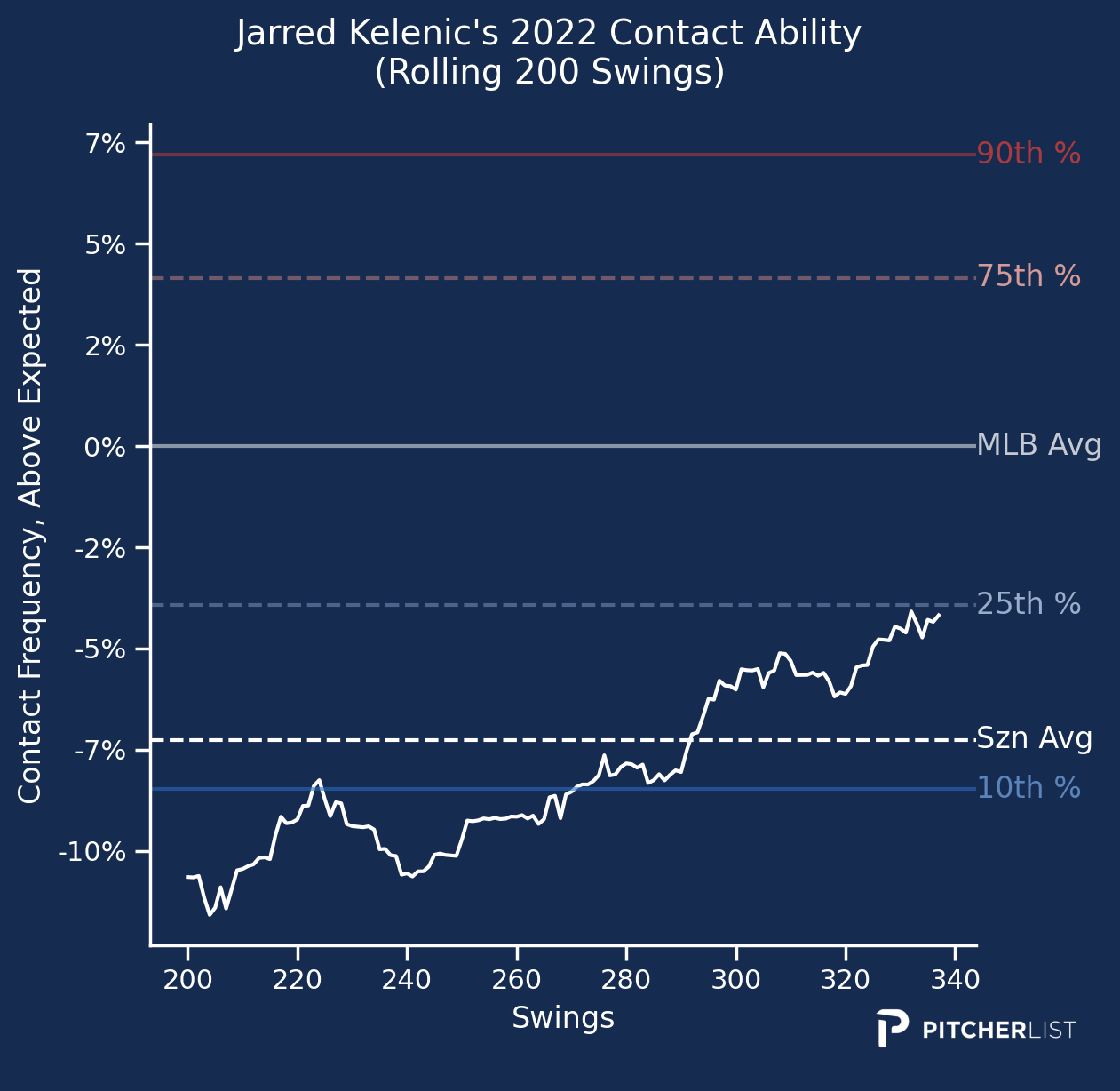
So why in the world am I adding him to my dart throws list? Two reasons: first, he has the natural talent to be a quality contributor to your fantasy team. The guy is still just 23-years-old and clearly has a good power speed combo (21 home runs and 11 steals in essentially one full major league season is pretty useful).
But the main reason is, Kelenic appears very aware of his problems and has been working to fix them this spring. According to the Seattle Times, Kelenic spent the majority of the offseason in Arizona and Southern California working with different hitting coaches with the goal of changing his swing. And he’s done exactly that, changing his stance at the plate as well as his swing.
A few more of Kelenic hitting off the pitching matchine which was set up to be similar to low 90s pic.twitter.com/oS2beMNP0N
— Ryan Divish (@RyanDivish) February 18, 2023
And here’s what I think is a pretty important quote from Kelenic to the Times:
“I don’t look at my inconsistent success in the big leagues as a lack of ability at all,” Kelenic said. “I look at it as a lack of information that I had. Just like this offseason, I learned a lot, had a lot of opportunities to learn from a lot of great people. Now that I have more information, I can go out and apply what I’ve learned. And I think you’re going to see a lot more successes here and we’re going to win a lot more games.”
That’s really encouraging. There tends to be two types of players when they struggle mightily in the big leagues—the guys who just keep doing the same thing over and over again hoping it’ll work and the guys who actually sit down, go through their approach, and make adjustments, and it sounds like Kelenic falls more into the latter group.
And so far, it seems like it’s working. Obviously these are spring training stats, so take them with the largest grain of salt you possible can, but so far this spring training, Kelenic is hitting .429 with four home runs in 21 games. I think he’s worth a gamble late in drafts in case he’s worked things out.
Ross Stripling (ADP: 291)
If you’ve been following me on Twitter or read some of my pitch review series, you’ve probably seen me hyping up Ross Stripling a good bit. I love him as a sleeper this year, and here’s why.
Stripling had some early success in his career with the Dodgers but in 2020 and 2021 with the Blue Jays, he was pretty bad (and mostly in the bullpen), posting a 5.84 ERA and 4.80 ERA, respectively.
But then, last year, Stripling was mostly starting again and turned in an excellent season, posting a 3.01 ERA, 3.11 FIP, and 3.57 xERA through 134.1 innings. So what changed? Stripling changed around his pitch mix. Take a look at 2021 compared to 2022:
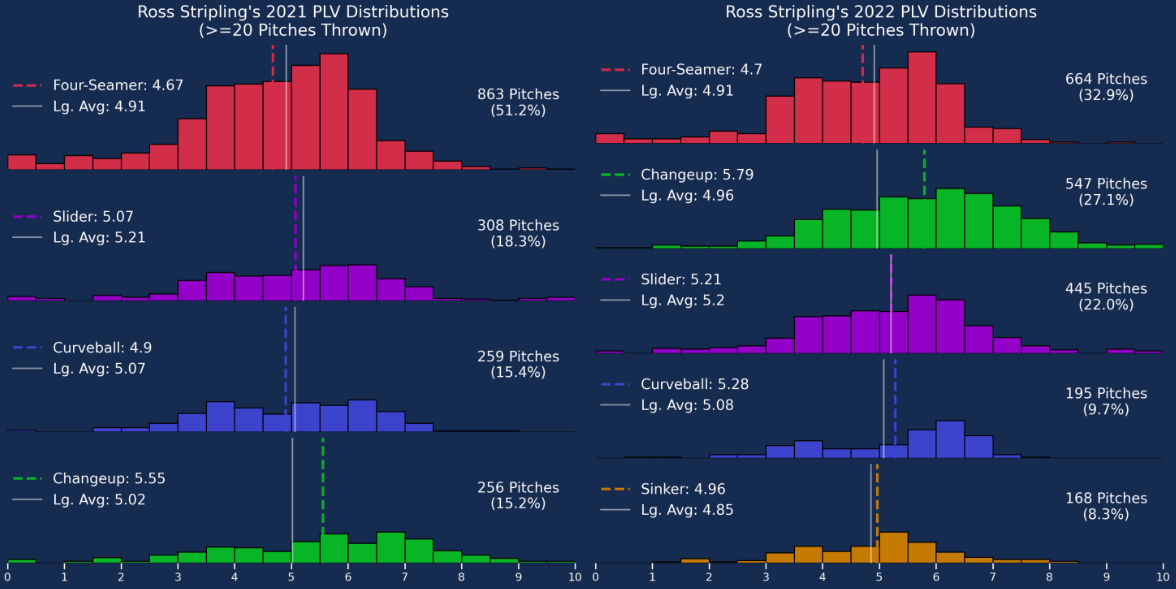
Stripling’s fastball isn’t all that great, so what did he do? Cut down how much he was using it. In 2021, he threw the pitch 51.2% of the time. Last year, it dropped to 32.9% of the time.
Stripling also cut down on his curveball usage (which is good because the curveball was not a great pitch) and significantly increased how often he threw his changeup, jumping from 15.2% in 2021 to 27% last year.
And that changeup is key. Here’s a look at it:
https://gfycat.com/shortdisastrousantipodesgreenparakeet
A few facts about Stripling’s changeup: It was the best changeup in all of baseball by PLV, the seventh-best pitch in the major leagues by PLV, and had the seventh-highest chase rate (46.7%) among all pitches in baseball (minimum 400 thrown).
Not only was it a good swing-and-miss pitch, even when batters did make contact with it, they didn’t do much with it, as the pitch had a .233 wOBA and .240 xwOBA against.
I’m a fan of Stripling’s approach last year. The fastball wasn’t great, but it was serviceable, with a .301 wOBA and .332 xwOBA against, but what I like was how Stripling used his slider and changeup together. He threw the slider early in the count fairly frequently (60% of the time, which is above-average for sliders) and then would throw the changeup in two-strike counts (45.5% of the time, well above average).
And here’s where he located them:

The slider would go low and glove side to set up the changeup that would be low and arm side. Tunnel those pitches well and they complement each other really nicely.
Stripling is with the Giants this year and I think he’ll have a spot in the rotation. Could I see him getting bumped for Anthony DeSclafani? Maybe. But after the season Stripling had last year, I don’t think the Giants signed him to be a long-reliever. And pitching in Oracle Park, one of the more pitcher-friendly ballparks in baseball, should be nice for Stripling too, and with any luck, he can turn in a similar year to last year.
Sean Manaea (ADP: 293)
Hey, speaking of new Giants pitchers! I’ve never been the biggest Sean Manaea fan from a fantasy perspective, even though he has turned in some decent seasons (though there’s definitely been more bad than good), but last year was not great.
Through 28 starts with the Padres, Manaea pitched to a 4.96 ERA, 4.53 FIP, and 4.20 xERA with a 23.2% strikeout rate and a 7.5% walk rate. But what’s interesting is Manaea’s repertoire doesn’t grade out all that horribly from a PLV perspective:
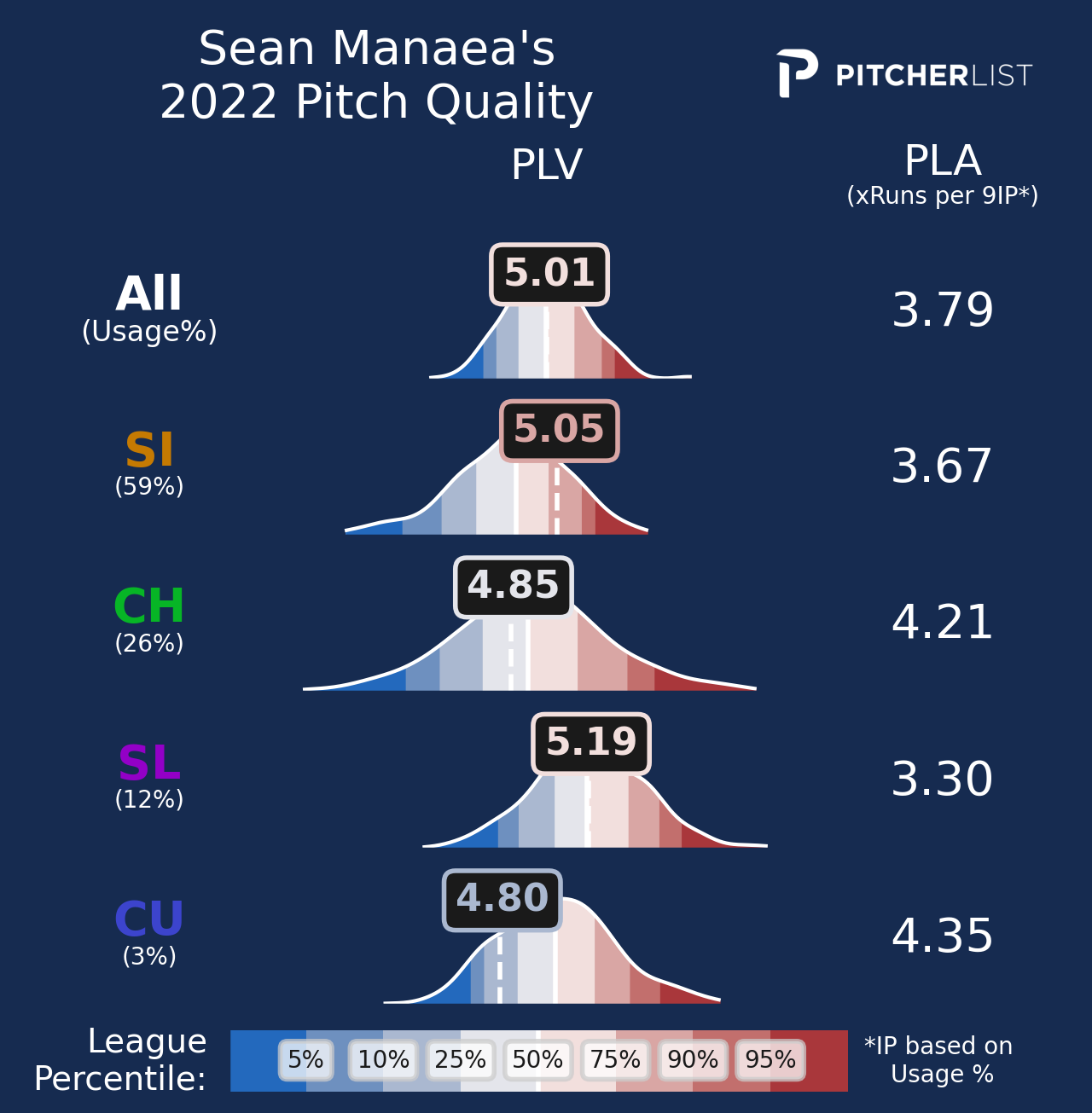
It’s not great, but it’s not that bad either. But that’s not why I’m interested in Manaea this year. I’m interested because of the changes he’s made in the offseason, specifically the fact that he did some work with Driveline and has tweaked his delivery around to be more efficient with his body movement, leading to some increased velocity.
Last year, Manaea’s sinker averaged around 91 MPH. This spring, Manaea’s sinker has sat around 93 to 96 MPH, which is a pretty big jump.
And on top of that, Manaea seems to really like the information he’s getting from the Giants’ pitching coaches. In that MLB.com article I linked above, Manaea said, “The information [the Giants’ pitching coaches have] given me and what they see on the analytical side, it’s kind of opened my eyes and made me realize some things. They know stuff’s in there. I believe in that, too. It’s nice to have those guys.”
This is one of those picks where I’m taking a shot on a guy who’s made some offseason adjustments. Sure, this could be one of those cases where someone shows up to spring training in the “best shape of their life” and then nothing else changes, but I think it’s worth a shot. We’ve seen pitchers go to Driveline, make changes, and have success before. Maybe Sean Manaea could do that too.
Kenta Maeda (ADP: 314)
Kenta Maeda had plenty of flashes of brilliance while he was with the Dodgers, but in the abbreviated 2020 season, his first with the Twins, he looked great, posting a 2.70 ERA, 2.99 FIP, and 2.34 xERA through 11 starts with a 32.3% strikeout rate.
But then 2021 came and Maeda looked way less brilliant, posting a 4.66 ERA with a 4.11 FIP and 3.98 xERA through 21 starts before injury ended his season prematurely and he had Tommy John surgery, which caused him to miss all of 2022.
So the question is, how much was Maeda’s injury affecting him in 2021 before he had surgery? Coming back from Tommy John, could Maeda be the pitcher he was before?
Honestly, I don’t think there’s a ton of downside into grabbing Maeda here. We’ve seen his ceiling, and it’s really impressive. He’s got a slider that gets plenty of swings and misses, posting a 36.4% chase rate, 17.4% swinging-strike rate, and a 32.9% CSW in 2021, and that in combination with his splitter—which had a 47.7% chase rate and 19.8% swinging-strike rate in 2021—make for two pretty excellent offerings.
Speaking of Maeda’s splitter, I’ll never pass up an opportunity to show a GIF of it, because it’s a beautiful pitch:
https://gfycat.com/adolescentbelatedbull
So far in spring training, Maeda has looked healthy, and with a newly repaired elbow, I think it’s fair to look at his rough 2021 with some skepticism, take a flier here, and hope we get to see a bit of the good Kenta Maeda come back.
Oswald Peraza (ADP: 321)
The thought process on drafting Oswald Peraza is pretty simple—it’s never a bad idea to bet on a young, talented player with opportunity in a good lineup.
Peraza looked pretty darn good in Triple-A last year, posting a .259/.329/.448 slashline with 19 home runs, 57 R, 50 RBI, and 33 steals through 99 games. And then, when he came to the majors, he looked pretty good too, slashing .306/.404/.429 with one home run and two steals in 18 games.
Obviously 18 games is like the smallest of all small sample sizes, but the point here is we know what kind of talent Peraza has and what his potential is, because he’s shown it in the minor leagues. He’s a guy who could steal 30-40 bases, hit for a decent average, and have double-digit home runs.
Now, of course, it could not be further from a guarantee that Peraza is actually able to do that. But I’d expect he’ll be the Yankees’ shortstop if not on Opening Day then pretty darn close to it (I can’t imagine they think Isiah Kiner-Falefa is more exciting than Peraza).
If Peraza is able to come even close to that ceiling, he’ll be well worth the late pick, and if he struggles like rookies often do, I think you’ll know it pretty quickly.
Ken Waldichuk (ADP: 382)
Ken Waldichuk only started seven games for the A’s last year and his numbers were not great, posting a 4.93 ERA with a 4.31 FIP and 4.58 xERA through 34.2 innings. But I mean, it’s seven starts, so I’m willing to look past that.
When I’m looking at sleeper pitching prospects, one of the things I often turn to is their stuff. If a guy has good stuff, a good pitch repertoire, then I’m interested in his chances at being a fantasy asset. And Ken Waldichuk showed some good stuff last year:
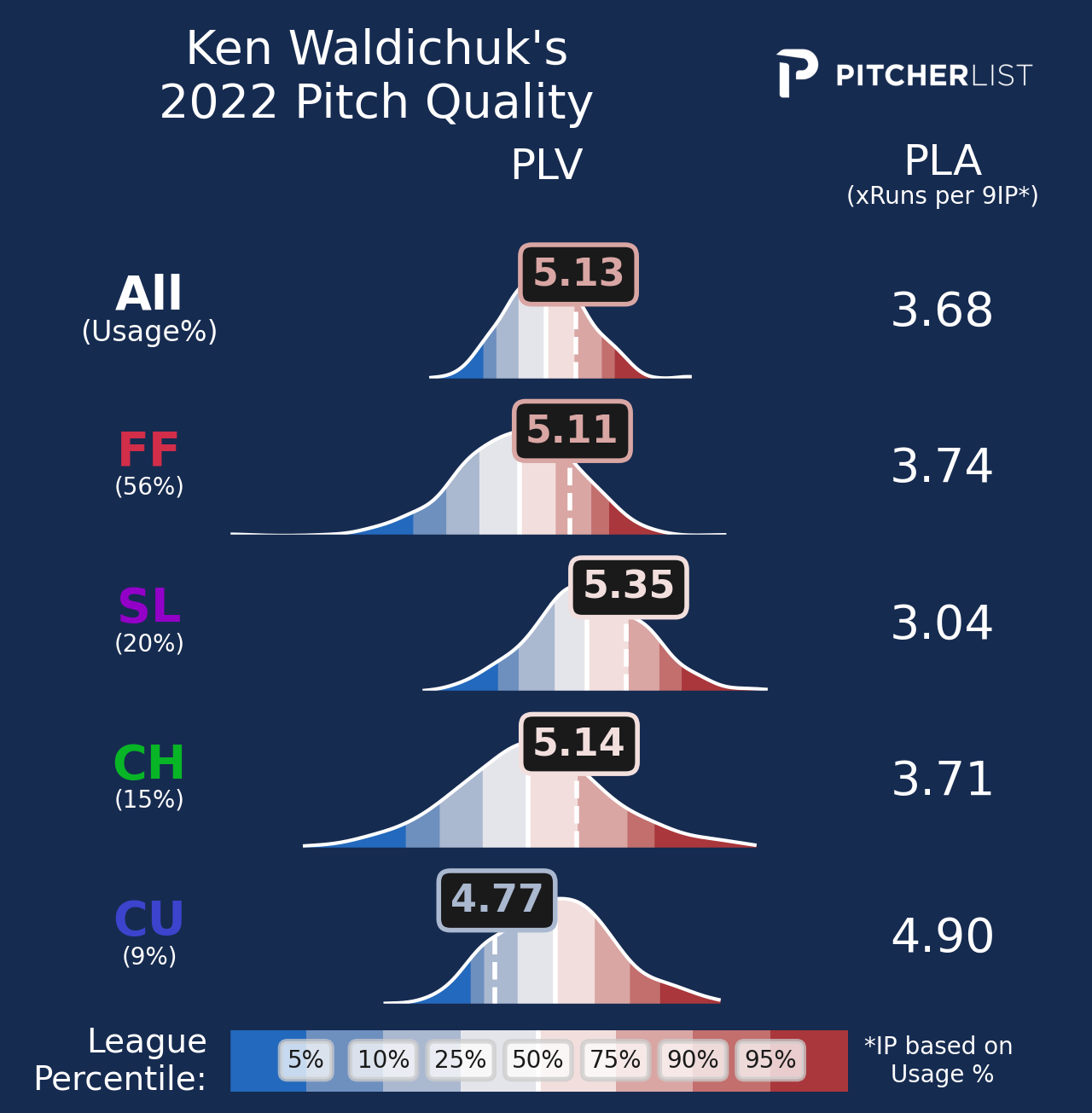
Every single pitch aside from his curveball (his least-thrown pitch) graded as well above average in PLV. Waldichuk works with a solid fastball that averages around 94 MPH and then works in a nice mix of his sweeping slider and changeup as secondary pitches.
And take a look at that slider:
https://gfycat.com/dangerousvaingourami
It’s a pretty sweet pitch, and last year it produced a solid 36.5% chase rate, 18.3% swinging-strike rate, and 29.2% CSW.
Our projections here at Pitcher List have Waldichuk posting a 3.76 ERA with a 24% strikeout rate in 25 starts next year. If you can get that at the tail end of your drafts, I’d be more than happy to take it.
Spencer Turnbull (ADP: 437)
I’ve been pumping Spencer Turnbull for what feels like an eternity now. He’s been a sleeper of mine for a long time, and I was getting especially excited once the 2021 season started and Turnbull was killing it, posting a 2.88 ERA with a 2.95 FIP and 2.76 xERA through his first nine starts (one of which was a no-hitter).
And then injury hit, and Turnbull needed Tommy John surgery, which took him out for the remainder of 2021 and all of 2022.
But it’s 2023 now! And Turnbull is healthy and back in the rotation! And I think he’s being summarily forgotten by a lot of fantasy players because 1. he’s on the Tigers and 2. they haven’t seen him pitch since June 2021. So let me remind you just how good Spencer Turnbull was before his injury. Here’s a look at his repertoire:
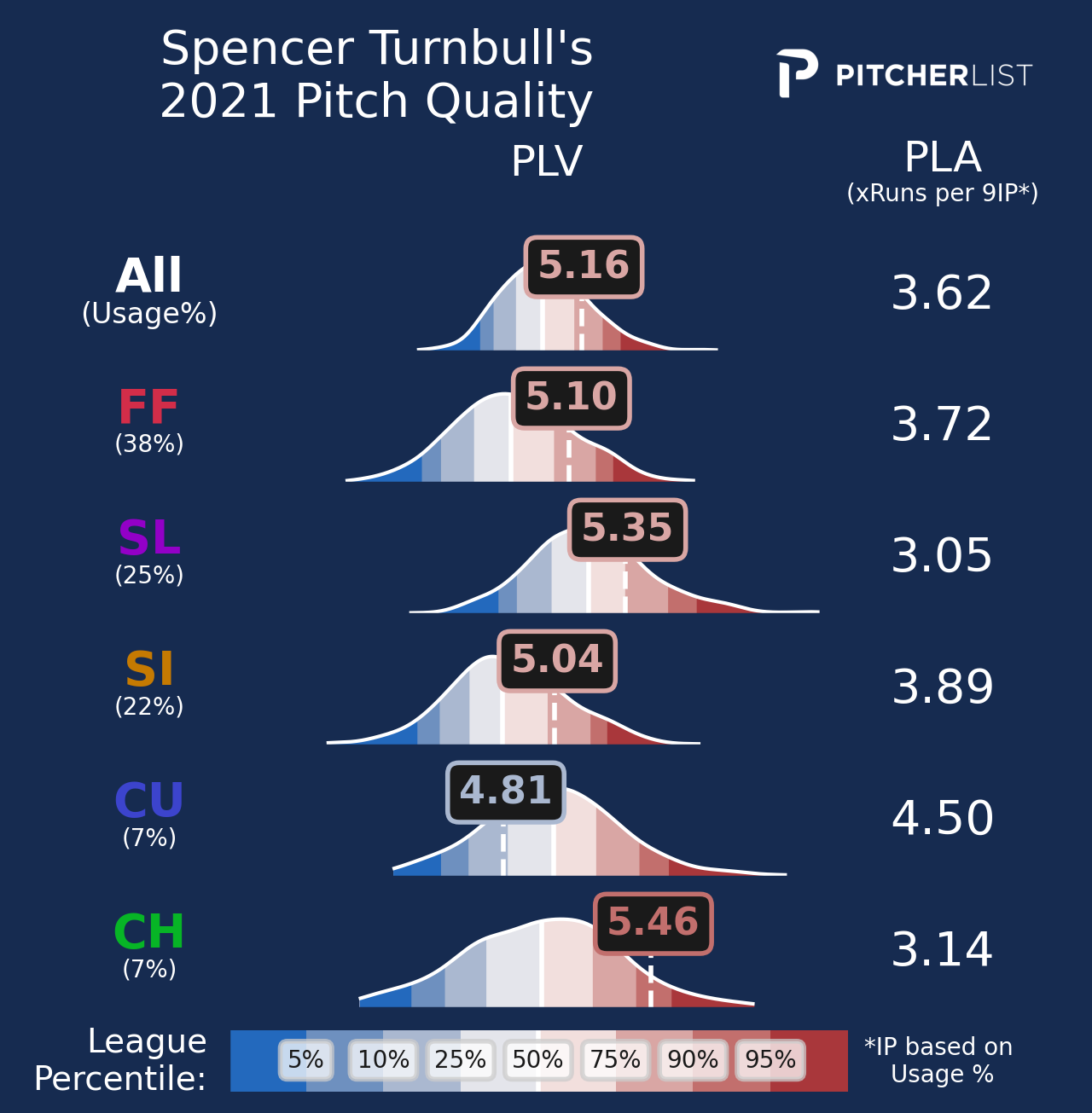
That’s a lot of good pitches.
Turnbull has always had a really good fastball, but what really worked beautifully is his slider:
https://gfycat.com/bountifulquarterlyhousefly
In 2021, that pitch posted a 35.4% chase rate, 18.4% swinging-strike rate, 36.8% CSW, and a .255 wOBA and .250 xwOBA against. And it wasn’t just 2021, Turnbull’s slider posted similar numbers in 2020 as well. It’s a killer pitch.
And complementing that is a sinker that averages around 95 MPH and is great at inducing weak contact, with a .256 wOBA and .262 xwOBA against in 2021.
So yeah, Turnbull has the stuff and now he’s healthy with a steady rotation spot. If ever there was a moment for him to really break out over the course of a full season, 2023 is it, so long as he stays healthy.
Ryne Nelson (ADP: 439)
Whether Ryne Nelson is worth a flier might change depending on how late in March you’re drafting. As of this writing, Nelson is battling out with a couple others (namely Drey Jameson and Brandon Pfaadt) for the fifth spot in the Diamondbacks rotation. If by the time of your draft there’s more clarity on whether Nelson is competitive for that spot of not, take that into account.
Nelson came up last year and looked pretty darn good in the three starts he pitched in, and PLV was a fan too:
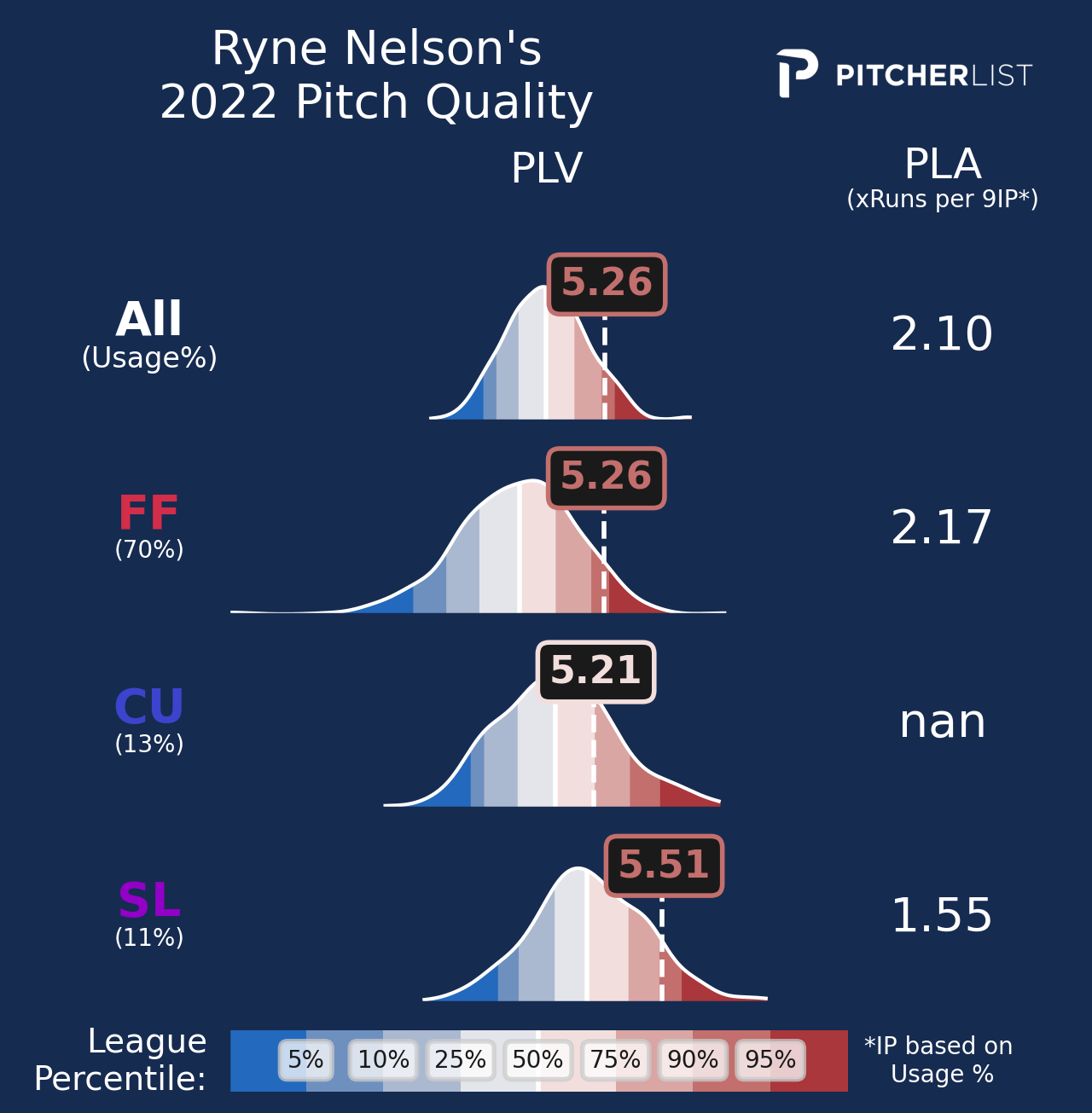
Now, again, extremely small sample size. Nelson had three games, but he looked pretty solid. His debut was against the Padres who, you know, are a pretty good team, and he went seven innings with seven strikeouts and no earned runs. Then, he went against the Dodgers (again, pretty good team) and went six innings with six strikeouts and no earned runs.
Nelson has a lively fastball that averages around 95 MPH mixed with a nice curveball and slider, he’s got the raw stuff to be a good pitcher and we’ve seen some flashes of it in the majors last year, so I think he’s worthy of a flier at the end of your draft.
Paul Blackburn (ADP: 555)
Paul Blackburn didn’t exactly have the best season last year, posting a 4.28 ERA with a 4.21 FIP and a 19% strikeout rate through 21 starts, but you know what Blackburn did have? A fantastic cutter.
https://gfycat.com/excitableshykestrel
That pitch was the second-best cutter in all of baseball by PLV and posted a 34.4% chase rate and 13.7% swinging-strike rate. Unfortunately, the pitch also had a .444 wOBA against it, but there’s reason to believe there was some bad luck there, as it also had a .321 xwOBA against.
Blackburn typically threw his cutter early in at-bats, at a clip of 70.6% in early counts, so it wasn’t really meant to be a strikeout pitch (though it still posted some good numbers). His strikeout pitch was his curveball:
https://gfycat.com/yawningthickballoonfish
That posted a solid 36.4% chase rate and 14.5% swinging-strike rate alongside a .223 wOBA and .230 xwOBA against.
So why wasn’t Paul Blackburn much better last year? He’s got a fabulous cutter and a solid curveball strikeout pitch. Well, the rest of his repertoire wasn’t so great.
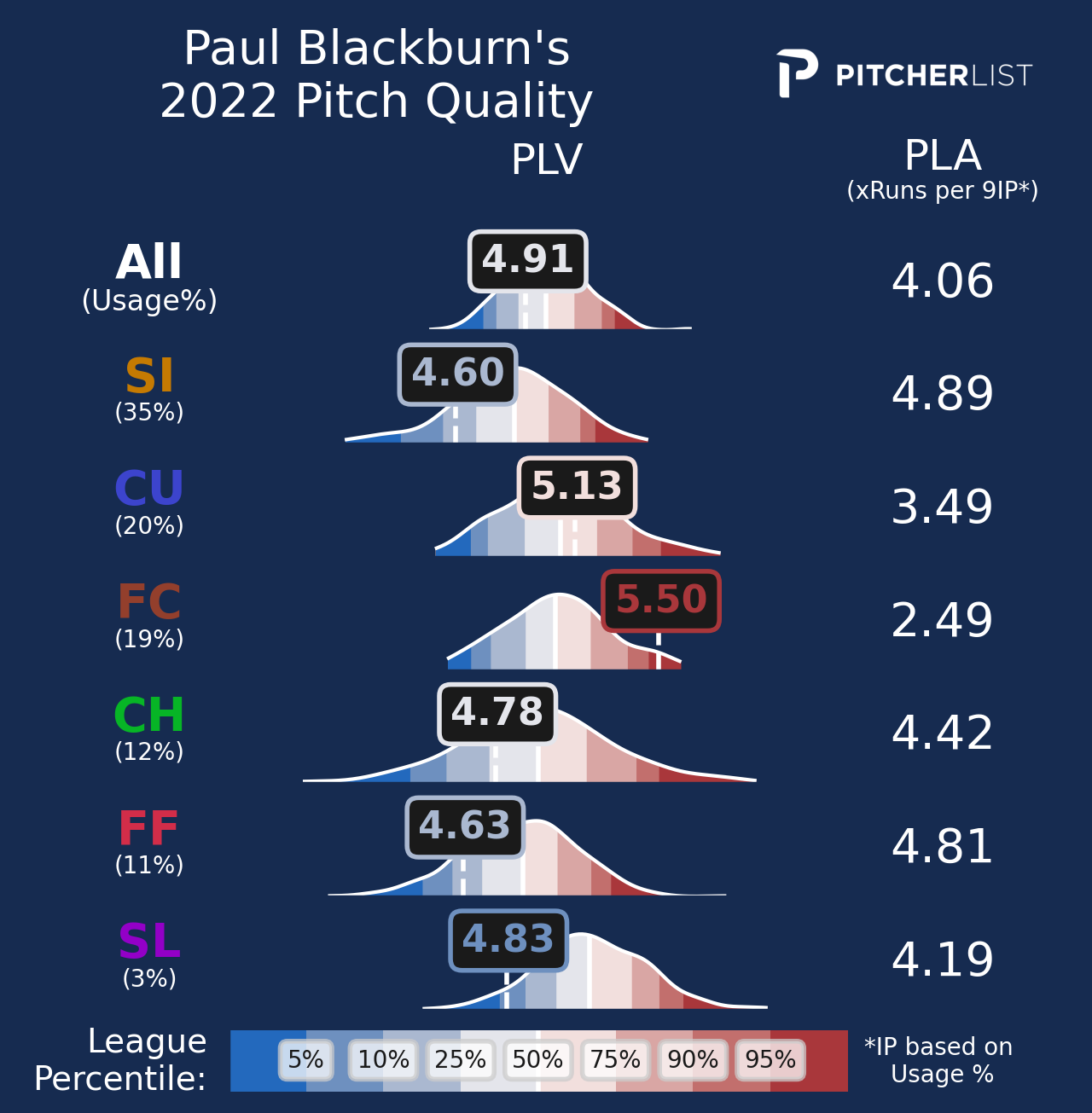
It’s not great when your most-thrown pitch is also your worst pitch, and that’s the case with Blackburn’s sinker, at least from a PLV perspective.
Here’s what makes Blackburn really interesting to me: he’s already got the fantastic cutter and the really good curveball, and there are reports that Blackburn is tinkering with his repertoire this spring. I could see two avenues that would be really interesting for Blackburn to go. If he were to decrease his sinker usage a bit and use that cutter more as his primary fastball pitch, that could be interesting (use your bad pitch less!).
Or, and this is what I think is probably more likely based on what Blackburn has said, he might start using his changeup more as a way to make his sinker more effective, thus giving him a better sinker to go along with his already good cutter and curveball.
Either way, when a guy has a couple nuggets of good stuff and I hear reports that he’s tinkering with things, that’s encouraging to me. Blackburn will have the opportunity, hopefully he can take advantage of it.
Adapted by: Chris Corr (@Chris_Studios on Twitter)

